|
|
The informal economy and its impact on tax
revenues and economic growth. The case of Peru,
Latin America and OECD countries (1995 – 2016)
|
|
Guillermo Boitano
Pontificia Universidad Católica del Perú
gboitano@pucp.pe
Deyvi Franco Abanto
Universidad de Lima
deyviabanto@gmail.com
https://doi.org/10.18800/360gestion.201901.005
|
|
|
El objetivo principal de la investigación es determinar el tamaño de la economía
informal en Perú, América Latina y los países de la OECD, así como estimar el
impacto de la economía informal en la recaudación tributaria y el crecimiento
económico. Para alcanzar el objetivo, la aproximación se realiza a través de
modelos MIMIC. Los resultados principales muestran que el tamaño promedio de
la economía informal como porcentaje del PBI en el Perú es 37.4%, en los países
de América Latina es de 34%, y de 19.83% para los países de la OECD; es decir, un
poco menos de la mitad del promedio de América Latina.
Palabras clave: economía informal, gestión estratégica, crecimiento económico, impuestos, América Latina
The main goal of the research will be to determine the size of the informal economy in
Peru, Latin America and OCDE countries as well as to estimate the impact of the informal
economy on tax revenues and the economic growth. To achieve the goal, the approach
is made through MIMIC (multiple-indicator and multiple-cause) model. The main results
show that the estimated average size of the informal economy as a percentage of the
GDP in Peru is 37.4%, in Latin America is 34%, and in OCDE countries is 19.83%, which
represents less than half of the Latin America average.
Keywords: informal economy, strategic management, economic growth, taxation, Latin America
|
|
|
|
|
1. Introducción
For the last 20 years, Peruvian economy has maintained a sustained growth of 5%, unlike
Latin America (3.8%) and OECD (2.7%). It has been one of the few economies to overcome
the 2008 crisis with a GDP growth. Accordingly, Peru's tax revenues (17% in 2015) have
also grown during the last 20 years, but not at the same magnitude as the OECD (35%) and
Latin American countries (22%) (OECD, 2016). However, in spite of being one of the most
solid economies in Latin America, there is a complex phenomenon: the informal economy,
with negative impact on both the economy and society. For the purpose of this paper, we
will use the definition of informal economy proposed not only by De Soto (1986), who
understands this phenomenon as a source of entrepreneurship that seeks income outside
the formal economy due to the pressures of government`s regulation, as well as the one
proposed by Buehn, Dell’Anno, and Schneider (2012), Schneider and Colin (2013), and INEI
(2016), that describes the informal economy as the set of productive activities subject to tax
and social contributions, consciously hidden from the tax authorities due to tax burdens.
Besides, in this paper, the theoretical concepts will be based on what was developed by
Voicu (2012).
Reducing informal economy is fundamental not only for tax collection purposes
–as tax base could be increased and tax evasion reduced–, but also for Peru’s economic
growth. However, focusing only in tax purposes, the tax structure in Peru and Latin
America is dominated by indirect taxes, which results in low redistributive capacity and
higher inequality. On the contrary, in OECD countries, the system is progressive meaning
concentrated in direct taxes. Concentrating on direct taxes improves welfare and equality
but is only possible by absorbing the informal economy and reducing informal employment
(OECD, ECLAC, CIAT & IDB, 2016).
Most of the phenomenon is analyzed from the economic perspective, even though
informal economy is also relevant within the management area. For instance, Godfrey (2011)
and Mc Gahan (2012) agreed that the informal economy is a «new frontier for management
scholarship and research (Godfrey, 2012, p. 233)» because these businesses structures
work in an environment where management theories could be stressed. Informality does
not imply the business does not look for returns, lack of strategies and avoids competition
and an ethical dilemma (Godfrey, 2011). Not including these activities in the management
analysis and research is to look at half of the picture (Mc Gahan, 2012). Complementing the
idea, Bruton, Ireland and Ketchen (2012) added that although the informal economy is an
important topic due to its great participation in the economy (especially the emerging ones)
there is little research about it and many possibilities to increase the knowledge on the topic
when expanding the areas of study beyond the features and character of the informality.
Bruton, Ireland, and Ketchen (2012) indicated that «the informal economy is the final frontier
of the management domain (p. 2)». Additionally, Welter, Smallbone, and Pobol (2015)
indicated that the informal sector is associated with the informal entrepreneurship that
offers empowerment, emancipation and participation to activity. The entrepreneurial spirit,
then, can empower people in a similar way to the first discussion on the duality between
the informal and formal economy (Welter, Smallbone & Pobol, 2015). Moreover, Darbi and
Knott (2016) described the SNP (Strategic Networking Practices) between companies in an
Guillermo Boitano & Deyvi Franco Abanto
130
informal economy around four interconnected topics: 1) open communication, 2) fraternal
substitution, 3) commitment, and 4) naturalization. It shows the degree to which tacticians
can bring non-economic and «non-rational» personal and social considerations to the
strategic decisions they make on behalf of the organization; thus, the total comprehension
of the strategic methods of informal businesses is improbable without considering these
types of stimuli (Darbi & Knott, 2016). These findings contribute to profound awareness of
the social linkage perspective on strategic networks, and to the use of SAP (strategy as
a practice) in strategic activities, options and practices aimed at individual professionals
immerse into a social environment (Darbi & Knott, 2016). After proposing four possible policy
options. Besides Williams (2015) showed that, if nothing is done, the existing undesirable
effects on formal entrepreneurs, informal entrepreneurs, customers, and governments
will remain. There is no evidence that formal sector deregulation addresses informal
entrepreneurship, whereas the eradication of informal entrepreneurship would result in
governments suppressing and destroying the entrepreneurial effort and the corporate
culture they actually try to foment; thus, the transformation of informal entrepreneurship
into a formal one is shown as the most possible political alternative (Williams, 2015). The
current method in which direct limits are used to enhance detection and escalate penalties
is still quite perfectible as there is a much broader set of tools – not mutually exclusive–
available to address informal entrepreneurship (Williams, 2015). Mukherjee (2016) indicated
that the informal economy is huge and will persist in time. Indeed, depending on how it is
defined, it could be the most dominant model of economic organization and therefore calls
for an appropriate policy response that can promote equitable linkages between formal
and informal economies. It rejected the idea that informal firms act as a weak substitute
for formal firms (Mukherjee, 2016). Finally, Mathias, Lux, Crook, Autry, and Zaretzki (2015)
pointed out that while property and social policies serve to permit formal activity and
decrease informal activity, structural and financial policies limit formal activity and rise
informal activity.
In sum, the main goal of this research will be to determine the size of the informal
economy in Latin America and OCDE countries to estimate its impact on tax revenues and
the economic growth, and to analyze the structural changes needed to increase formality.
Especially attention will be paid in the case of Peru, trying to elaborate recommendation
to better understand its informal economy and how to integrate it into the national formal
economy.
2. Definition of informal economy
An open definition rather than a concrete and closed one is needed due to three reasons:
1) a singular and arbitrary definition could leave out many characteristics and not reflex
the current phenomenology, 2) a precise definition could end up with an inadequate
mechanism of measurement, and 3) different countries have informal economies with
different characteristics (Eilat & Zinnes, 2000). Bovi and Dell’Anno (2009) recognized that
the shadow economy has not a unique and agreed definition, nor does it have a common
name.
Smith (1987) defined the informal economy as a non-formal one that does not
consider in the national accounts. Ogunc, Fethi, Yilmaz, and Gokhan (2000) mentioned
that a «parallel» or «shadow» economy are terms used to refer to it although no formal
agreement exists about a definition. Schnider (1986), cited by Ogunc et. al. (2000), defined
the informal economy as the set of activities that add value and could be accounted
for the national income but are not registered. Smith (1994), as cited by Ogunc et. al.
(2000), considered the production of goods and services that are not included in the GDP.
Bagachaw (1995), cited by Ogunc et. al. (2000), points that it should be divided into three
categories: 1) the informal sector, 2) the parallel markets, and 3) the black markets. Eilat and
Zinnes (2000) mentioned that the term «informal» has been mainly used to refer to small
and artisan activities usually carried out in developing countries. Other terms recognized
by Eilat and Zinnes (2000) are «hidden» and «underground» economy, used to refer to tax
avoidance; the «parallel» and «black» economy, refer to illicit activities; the «unofficial»
and «unrecorded» economy refer to non-recorded activities in the national statistics; and
«shadow» economy (following Tanzi (1982)) points out activities in which the government
has not intervened or endorses.
Frey and Schneider (2001) recognized terms such as «informal», «unofficial»,
«irregular», «parallel», «second», «underground», «subterranean», «hidden», «invisible»,
«unrecorded», «shadow», «moonlight», and «black». There is not a unique definition and
all of them depend on the objective of the analysis. Thus, the normal way of treating the
informal economy is relating it to an unrecorded activity in the GDP. However, under this
assumption, activities such as household activities and tax avoidance are not included in
the statistics because they are not value-added activities (Frey & Schneider, 2001). Finally,
Frey and Schneider (2001) specified that the informal economy cannot be confused with
illegality (activities against the Law such as drug distribution, for instance (p. 7442)).
According to Gylys (2005) there are several terms used for defining the informal
economy, most of which are related to negative aspects of the phenomenon. What matters
more is the fact that the attention is set more in the name than in the fundamentals of the
economic phenomenon (Gylys, 2005). Hence, in the economic life, there are five different
aspects to consider: 1) the official or regulated economy, 2) the unofficial or unregulated
economy, 3) activities not fulfilling with official requirements, 4) registered activities, and 5)
unregistered activities. The first three are linked to formality of the economic activity while
the last two relate to the possibility of registration of the activity (Gylys, 2005).
According to Brambila and Cazzavillan (2010), the terminology «informal economy»
was first used by Hart (1973; 1990) to explain the characteristics of the labor market in
Africa. In addition, Brambila and Cazzavillan (2010) also mentioned all the different ways to
measure it. This definition is used by the International Labor Organization (ILO) and implies
that informality is characterized by a high incidence of poverty, inequality and vulnerability
compared to the normal labor deficit standard.
Wan Jie, Huam, Rasli, and Thean Chye (2011) summarized several definitions of the
informal economy based on its causes and taxonomy to better understand the concept and
to reduce the degree of misconceptions. Webb, Bruton, Tihanyi and Ireland (2013) defined
the informal economy as «economic activities that occur outside of formal institutional
boundaries, but which remain within informal institutional boundaries for large segments of
society. Given this definition, informal economy activities are technically illegal yet are not
antisocial in intent (p. 1)».
3. Theoretical approach to the informal economy
Although Frey and Weck (1983) indicated that there is a deficiency of a theoretical structure
to specify the connection between the private sector, the government and the informal
sector to determine the main causes and effects of the informal economy, the later research
foster a framework for the phenomenon. Thus, Wilson (2011) indicated that there are three
ways to view the informal economy: 1) the dualist approach, which considers the informal
sector as an underdeveloped one, where activities are undertaken by low skilled migrants
and the lower skills of the informal workers (2012); 2) the structuralist approach, which
looks for the connections between informal and formal economy as the last one takes
advantage of the first one, following the inner character of the capitalism: looking for more
competitiveness Chen (2012) ; and 3) the legalist approach, that conceives the informal
economy as a product of a mercantilist government: the way for new entrepreneurs to
avoid bureaucratic regulations and succeed in the market. According to Chen (2012), the
cause of this last approach is the «hostile legal system (p. 5)». Finally, Chen (2012) included
the so-called voluntarism approach, according to which informal economy exists because
entrepreneurs openly want to evade taxation and, therefore, they must be forced to
become formal to avoid the inequitable competition.
Galiani and Weinschelbaum (2011) recognized three stylized facts about
informality: 1) small businesses are more probable to operate informally, 2) unqualified
people are more likely to work informally, and 3) workers that are not head of the house are
more likely to work informally in comparison to the head of the house. They then used these
facts to develop a model that clarified the behavior of firms in terms of formal or informal
work, and the corresponding behavior of the labor force and households. Thus, Galiani and
Weinschelbaum (2011) proposed as a policy that «governments should not consider only
labor demand but also labor supply when tackling informality (p. 837)» in addition to the
government needs of enhancing the role played by household in the phenomenon.
McGahan (2012) indicated that management researchers have become more
interested in studying the informality but there are problems related to both the collection
of data and the use of a conceptual definition. Informal activities such as the buses that
pick-up people at regular intervals and in specific places in Nairobi and Los Angeles are
good example for informal economy structures. In fact, for McGahan (2012) the informal
economy is decisive, so he points out:
studying informal activity yields important insights for mainstream theories
of management, pointing to areas of new theorizing on the boundaries of
the firm, diversification, dynamic capabilities, absorptive capacity, property
rights, governance, stakeholder theory, disruptive technology, innovation,
and organizational legitimacy. I argue that research on this sector is not only
an opportunity for management scholars but, also essential to the continued
relevance and vitality of management as a discipline (p. 12).
According to Webb et. al. (2013), most of the research about the informal economy
was centered on phenomenological aspects rather than theoretical ones. Since researchers
in areas such as entrepreneurship and management have become more interested in the
informal economy, a new theoretical framework is needed to analyze the phenomenon
(Webb et. al., 2013): institutional theory, motivation-related theories, and resource allocation
theory are the used ones. In the case of institutional theory, the idea is to analyze how the
institutional setting influence entrepreneurship in the informal economy. The motivationrelated
theories help to understand and structure the reasons why individuals become
informal. And the resource allocation theory shows how strategies are set up to take
advantage of opportunities in a resource-constrained scenario (Webb et. al., 2013).
In the same line, Gibbs, Mahone, and Crump (2014) tried to examine three
theories «culminating in the development of a contextual framework that suggests
appropriate theory selection for informal economy entry decision (p. 33)». These theories
could help policymakers to better understand the phenomenon and increase the theoretical
knowledge about the informal economy. The approach of Gibbs, Mahone, and Crump (2014)
is based on the integration of contextual factors (socio-spatial variations), entry typologies
(necessity-based versus opportunity-driven), external structural factors (structuralist, neoliberal,
and post-structuralist). Factors such as values, customs, culture, cognitive variables,
and social norms are not considered into the analysis and they should be included in future
research. In this line, Achua and Lussier (2014) analyzed the informal business sector in
Cameroon in three subgroups based on surveys: 1) streetwalker entrepreneurs, 2) street
corner entrepreneurs (both driven by necessity) and 3) street owner entrepreneurs (driven
by opportunity). Policies that sustain and encourage informal entrepreneurs at a local
level would be jointly valuable, with more than half of those starting out as need-driven
entrepreneurs progressing to opportunity-driven entrepreneurs form part of the formal
economy (Achua & Lussier, 2014). This shows up the necessity for policy variations to
support entrepreneurs in the informal economy rather than continuing ignoring them as
most governments do.
4. Main causes of informality
Studies on the subject cannot explain the existence of this phenomenon, although there
are several ones that would explain its birth. In general terms, some authors point out
that the main causes are linked to income inequality, poverty, unemployment, economic
growth and economic crises. Other authors consider that causes are more linked to the
excessive regulation introduced by governments and a high tax burden. Within the subject
of excessive regulation, some authors place special emphasis on social and labor regulation
(social security contributions, vacations, etc.). Another reason frequently mentioned is the
so-called social contract or social agreement established between a government and the
country’s population, emphasizing in the concept of tax morale. Institutionalism understood
as the transparency of institutions and governments, as well as the corruption and how laws
and regulations are applied, are added as other causes of informality. Finally, education and
behavioral causes are also considered as a relevant element to understand why informal
agents stay in informality. The causes of informality are summarized in Table 1:
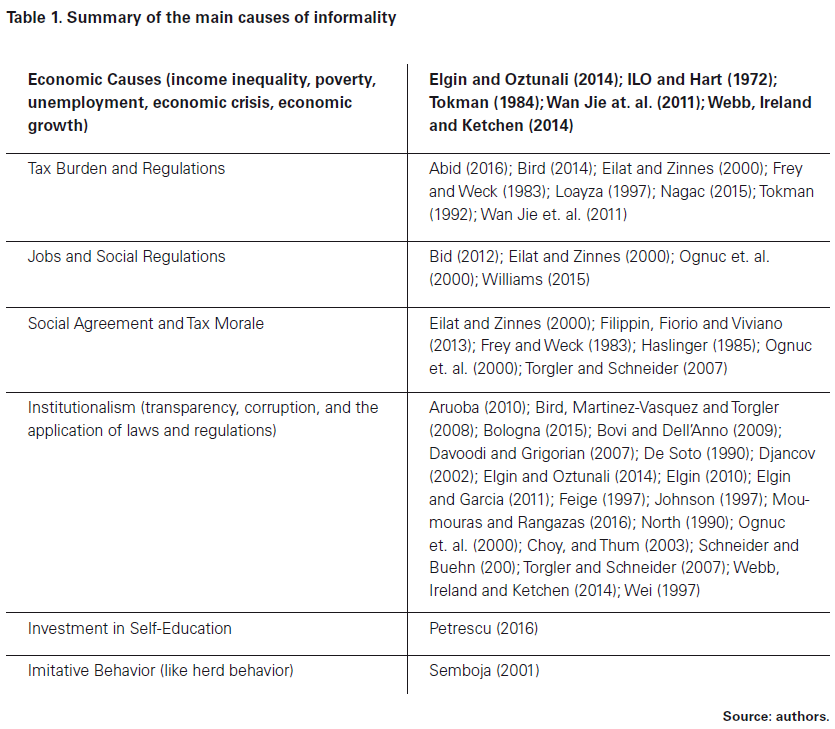
5. Main consequences of informality
In a similar way that with the causes, the consequences of this phenomenon are numerous.
The effects on economic, social and tax policies are highlighted by informal economy: the
greater the degree of informality, the less effective the social and economic policies become
(ant-inflationary policies, fiscal expansion policies, fight against poverty etc.). Also, lower
level of tax collection is achieved, affected not only by the lower tax compliance per person
but also by the lower tax base. There are also effects on the labor market, specifically in
terms of jobs creation, labor costs, and the skills and productivity of the labor force that
operates in the informal sector, all of which have an impact on the wealth of the population
and the labor regulation. Some authors emphasize the effect of the informal sector on the
market, specifically on the competition between formal and informal companies, considered
disloyal as informal companies don’t comply with regulations, artificially maintaining lower
cost structure. On the other hand, it is recognized that companies operating in the informal
sector tend to be firms with a limited technological capacity and innovation due to, among
other factors, the restriction of funding sources and trained labor, which leads to a reduced
level of productivity and the limitation of value-added. In sum, informal economy ultimately
effects negatively on economic growth of a country. The main consequences of informality
are summarized in Table 2:
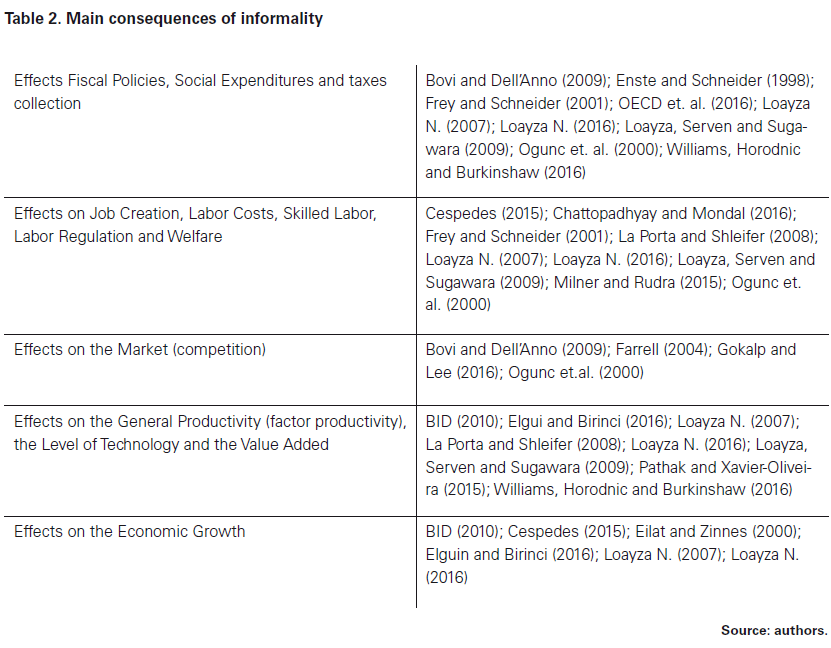
6. Formalization reforms and their results
BID (2010) showed the effect of flexible tax regulation and the existence of subsidies on
the informal economy. These issues are further explored by Gómez and Morán (2012), who
analyzed the development of taxation policies in Latin America and showed that spending
in collecting institutions is higher than in developed countries (OECD). Feld and Schneider
(2010) found that, in OECD countries, the level of dissuasion to neutralize informality did not
work well. BID (2012) found that flexibility in tax regulations is better since greater coercion
does not dissuade informality. However, Gómez and Morán (2012) showed that despite the
progress made in reducing the informal economy due to the implementation of policies to
formalize economic agents, yet informality remains with high costs in terms of tax revenue.
Joshi, Prichard and Heady (2014) analyzed the diverse ways in which governments promote
formalization and taxation of informal. There is a belief that taxing informal firms serves
to raise money; however, there is a negative aspect related to the high cost of collecting
and monitoring the process. Besides, taxing informal firms raises issues like coercion and
corrupted behavior from the tax officials. As Joshi, Prichard and Heady (2014) said, the main
reason that leads informal firms to pay taxes is the promotion of a tax culture in a country.
About the mechanisms used by governments to formalize and include informal activities
into taxation, the most used is VAT or indirect taxation (Joshi, Prichard & Heady, 2014).
Other ways to incorporated informal firms in the tax base are enhanced enforcement
and compliance, tax rewards, tax discounts, withholding taxes, and presumptive taxes.
Nevertheless, all these alternatives have shown several problems such as the creation of
complicated tax systems and costly processes of collection and monitoring, as well as
unfairness problems. Even though more research is required, Joshi, Prichard and Heady
(2014) show that there are fewer incentives to promote a formalization and taxation reform
on the side of the politicians and tax officials. Tax evasion is not the main reason for
becoming informal: avoiding regulations, the complexity of the tax system, and the cost of
formalization are probably more important reasons (Joshi, Prichard & Heady, 2014). Many
times, as indicated by the authors (2014), an agent becomes informal due to the lack of
skills and illiteracy (what is called the absence of capacity) and, therefore, is an involuntary
movement. In this case, a formalization program should include not only the adaptation
of the tax system to the characteristics of the informal firms but also topics related to
property rights and dispute resolutions. The interaction between the informal sector and the
government in terms of information (communication about the benefits of being formal),
credibility (government fulfilling its commitment), and coordination (reform including most
of the informal sector) must be addressed when working towards formalization (Joshi,
Prichard & Heady, 2014).
7. How to measure the informal economy
There are two groups of methods: direct and indirect. In the first one, surveys are most
used. In the second one, several methodologies co-exist: the official participation rate of
labor or the employment approach, the income and expenditures approach, the tax fraud
estimation and tax auditing approach, the demand of money or monetary approach, the
transaction approach, the total electricity use, the modified total electricity-based approach,
household electricity use, and the MIMIC and SIMIC models (Andrei, Stefanescu & Oancea,
2010; Eilat, & Zinnes, 2000; Frey & Schneider (2001); Frey & Weck, 1983; Hernandez, 2009;
Ogunc et. al 2000); Smith (1987) used another way to measure the informal economy:
using household purchases from informal vendors. While the advantage of this method is
that buyers are willing to disclose the information, the disadvantage is the differentiation
the buyer has to do between formal and informal vendor.
The lack of interested in the causes and reasons for becoming informal (Frey &
Weck, 1983) complicates the measuring of informal economy. Although there are many
methods to measure the informal economy, Hernandez (2009) recognized that measuring
it is still a problem due to both the lack of a unified definition and the lack of information.
8. Measuring the informal economy in Peru: application of multiple-indicator and multiple-cause models
A multiple-indicator and multiple-cause model (MIMIC) derivative from the structural
equations modeling is used in this research to measure the informal economy. This model
incorporates the causes and consequences of this economic phenomenon into a single
indicator that encompasses all the characteristics of the informal economy. It is important
to remember that, in the case of Peru, a previous measurement was done by Hernandez
(2009), who decided to use the currency demand approach under which «the informal
sector or hidden economy refers to all activity that adds value but is not taxed or registered,
and consequently is beyond official channels of measurement, as mentioned by De Soto
(1986) and Loayza (1996) (p. 86)». Hernandez (2009) indicated that the currency demand
approach (the excessive use of currency) has been criticized due to «the sensitivity of the
results to the assumptions of the model (p. 86)». Hernandez (2009) concluded that the
share of the informal economy on the Peruvian GDP is about 44% to 50%, between 2000
and 2005, which is a result that could be greater if other activities like the illegal ones are
included. In addition, Machado (2014), uses the MIMIC methodology to estimate the size
of the informal economy for the years 1980-2011, his results fluctuate between 30% and
45% of the GDP, his study uses as causes and indicators the variables tax rates, inflation,
GDP per capita, tax evasion rate and net primary enrollment rate. Unlike Torgler & Schneider
(2007) who also use the same methodology, Machado (2014) does not use institutional and
macroeconomic variables to create the size of the informal economy.
In the case of the MIMIC models, Goldberger (1972) pointed out that Structural
Equation Models (SEM) are widely used in behavioral, social, and economic studies to
analyze structural relationships among variables. Some of them may be latent (unobservable)
and SEM cover a wide variety of models and methods for multivariate analysis. Breusch
(2005) indicated that because the informal economy cannot be observed, therefore it
should be estimated. Thus, Breusch (2005) used a MIMIC model to measure the informal
economy. Breusch (2005) recognized that the model has been used in the factor analysis of
psychometrics and, at the beginning, it was used by Zellner in 1970 and Goldberger in 1972
(Breusch, 2005). In the case of the informal economy, Frey and Weck-Hannemann were
the pioneers of using MIMIM models in 1984 (Breusch, 2005). After that, in 1988, Aigner,
Schneider y Ghosh used a refined model called DYMIMIC (because of the use of lagged
variables) (Breusch, 2005). Further, in 1999 Gyles modified again the model to include timeseries
concepts such as unit roots and cointegration (Breusch, 2005). In their research, Giles
and Tedds (2002) presented a Dynamic MIMIC called DYMIMIC (Breusch, 2005). Brambilia
and Cazzavillan (2010) used the MIMIC model to measure informal economy because they
considered that this type of model overcomes the problems of other methods by avoiding
restrictions on the available information and using several variables.
Acock (2013) argued that modeling structural equations offers the ability to use
multiple indicators for each latent variable and isolate it from each measurement of the error,
thus eliminating it for each latent variable assigned. Besides, the power of the prediction
given by the measurement of the error is assumed variable (a random error) and as such has
no explanatory power (Acock, 2013). The results are estimates of the trajectory coefficients
that would generally be larger than if no error was assumed in the predictors, as assumed
with the traditional regression models. The trajectory analysis part of the model is called
structural model and shows the theoretical causal links between the latent variables.
The MIMIC model identifies economic and social phenomena through the
relationships between the variables of their causes and consequences, which is a
necessary aspect but not sufficient. For a MIMIC model to be useful, stronger theoretical
justification is needed. The use of indicators of the model is shown in the section called
«causes and consequences (indicators)» located above. Figure 1 shows the relationship
between the observed variables (indicators and causes) and the latent variable (size of the
informal economy), which is not directly observed but inferred through observed variables
directly measured. Thus, the MIMIC model is divided into two equations: 1) the structural
model and 2) the measurement model.
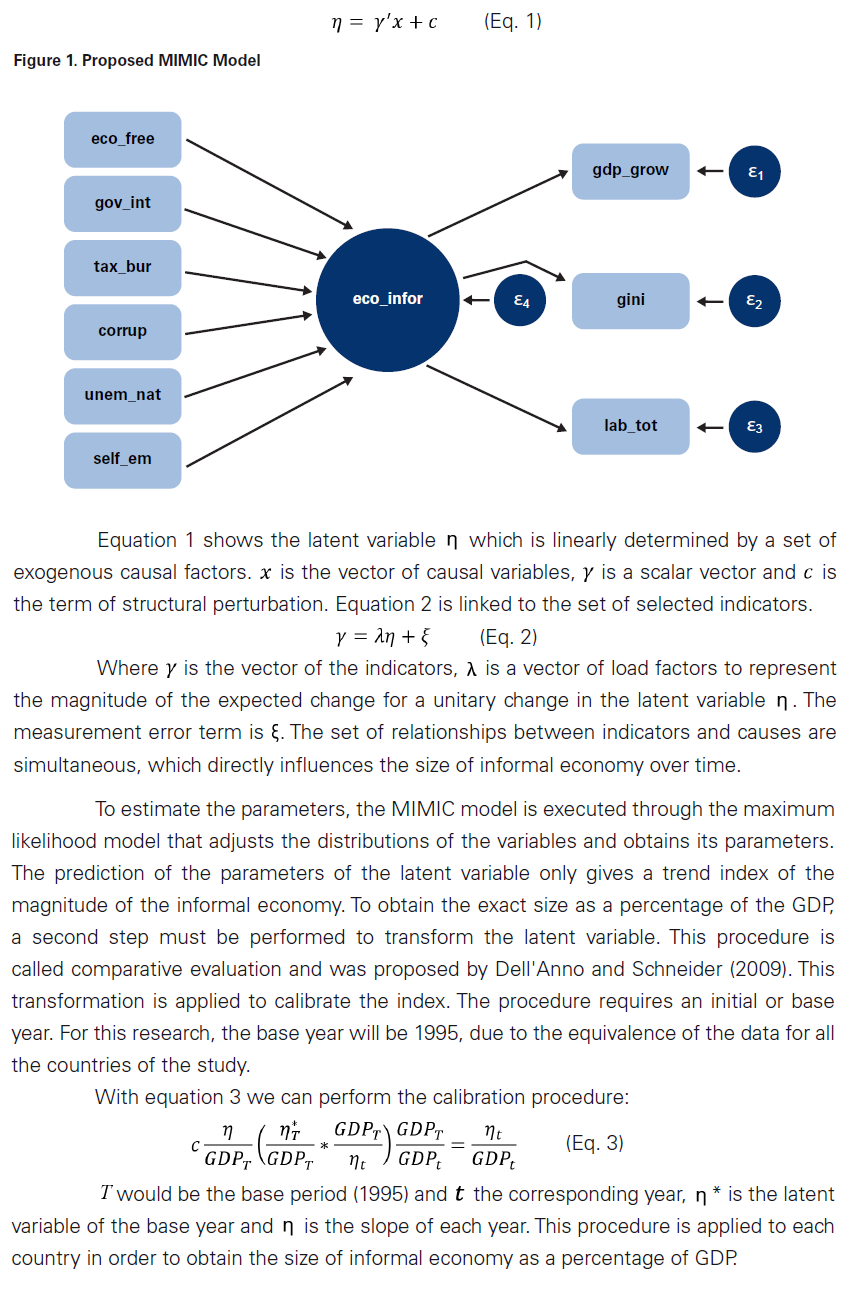
To estimate the magnitude of informal economy we use the maximum likelihood
method with a special specification called Satorra-Bentler adjustment. This is done to improve
chi-square statistics of the goodness of fit. In the case of Satorra-Benter, an estimation in
maximum likelihood for non-normal variables can be done because it compensates for the
non-normality of the variables to obtain a robust estimate. The method is described as a
correction of distributions of non-normal variables.
Satorra and Bentler (1994) develop the correction of the value of regular chi-square
for non-normality that requires the estimation of a scale correction factor (c). This reflects
the amount of average kurtosis that distorts the test statistic in the data being analyzed. The
chi-square value of goodness of fit for the model is divided by the scale correction factor to
obtain the so-called Satorra-Bentler chi-square (SB). Normality tests are applied to check the
use of Satorra-Bentler with the variables both separately and as a whole.
After explaining the detail of MIMIC model estimation, the results are summarized
in Appendix A. The indicators are statistically significant although the same significance is
not found in the case of all the causes. Beyond the significance analysis, the economic
analysis and interpretation of signs become the most important matter. Based on the
premises, MIMIC model 3 is chosen because variables fulfill the economic theory and
satisfy the relations among the variables and the informal economy.
Among the causes we have the economic freedom index that is significant and
related negatively to the latent variable; the government integrity index not significant but
fulfilling the negative relationship with the informal economy; the significant tax burden
index and its positive and proportional relationship –the higher the tax burden, the greater
the informal economy; the significant self-employment rate and its positive relationship
as its growth indicates higher unemployment and therefore a transfer in the informal
employment; tax revenues are not significant but their relation is negative, because the
lower the tax collection, the greater the informal economy; and finally, as self-employment,
unemployment is also directly proportional to informal economy, with greater presence of
the latent variable.
Indicators are affected by the dimension of the informal economy. Thus, the
Gini coefficient is significant, and it shows a positive relationship with informal economy
(the greater the inequality, the greater the latent variable); the labor freedom index is
not significant, but its relationship is negative as a lower labor freedom means a higher
informal employment; GDP growth is significant, but with a positive relationship. Hassan
and Schneider (2016) took the GDP variable as a reference and associated it with -1. This
modification is called «reduction ad absurdum» which is based on the negative relationship
of informal economy with GDP growth that is fulfilled for developed countries (OECD).
However, this research found that this variable has a positive relationship in Latin American
countries.
We apply the Generalized Method of Moments (GMM) to observe the impact of
informal economy on economic growth and tax collection, while identifying the relationship
between the dependent and the instrumental variables. The method is appropriate
because informal economy has many causes and consequences that relate to each other.
Hayashi (2000) indicated that the most critical assumption made for the OLS model is the
orthogonality between the error term and the regressors: without it, the OLS estimator
is not reliable. Since in many important applications the orthogonality condition is not
satisfied, it is essential to be able to deal with the endogenous regressors (Hayashi, 2000).
Guillermo Boitano & Deyvi Franco Abanto140
The estimation method called the Generalized Method of Moments (GMM), which includes
OLS as a special case, provides a solution (Hayashi, 2000). In the frame of this research, the
assumption of strict exogeneity does not apply for the model presented because informal
economy affects many other variables outside the model and requires instrumental variables
pertinent to the correlated (endogenous) variables with the error term. To comply with the
GMM assumptions, the model must be linear in compliance with the model proposed by
Hayashi (2000).
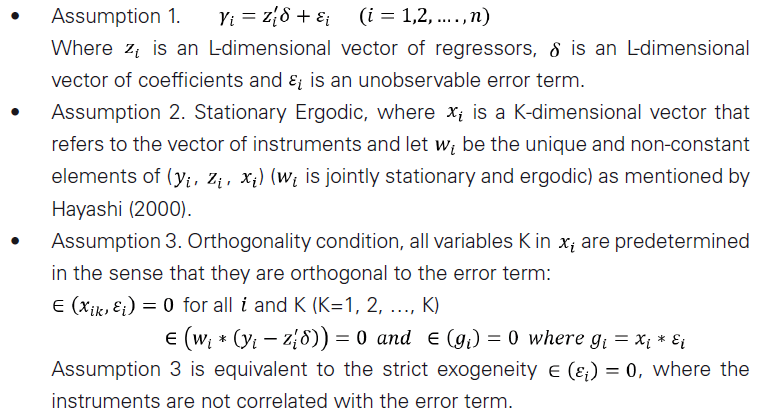
Torgler and Schneider (2007) and MEF (2016) used the Generalized Method of
Two-stage Moments (G2SM) due to the high endogeneity presented by the variables that
cause informality. This method corrects problems of endogeneity and includes instrumental
variables accomplishing a better explanation of the variables that have a high correlation.
Hayashi (2000) deals with this problem estimating more than one equation jointly
by GMM. After using GMM in a single equation it is necessary to follow a few more steps to
arrive at a multiple equation system. This is because the multiple equations GMM estimator
can be expressed as a simple equation GMM estimator by properly specifying the matrices
and vectors comprising the simple equation GMM formula. This being the case, it can be
developed the GMM large sample theory of multiple equations almost off the platform.
Hayashi (2000) considered that the gain of dominating the GMM multiple
equations is considerable. Under conditional homoscedasticity, it is reduced to the efficient
estimator of the instrumental variable of complete information, which in turn is reduced
to the three-stage least squares (3SLS) if the set of instrumental variables is common to
all equations. If it is further assumed that all regressors are predetermined, then 3SLS
is reduced to seemingly unrelated regressions, which in turn is reduced to multivariate
regression when all equations have the same regressors.
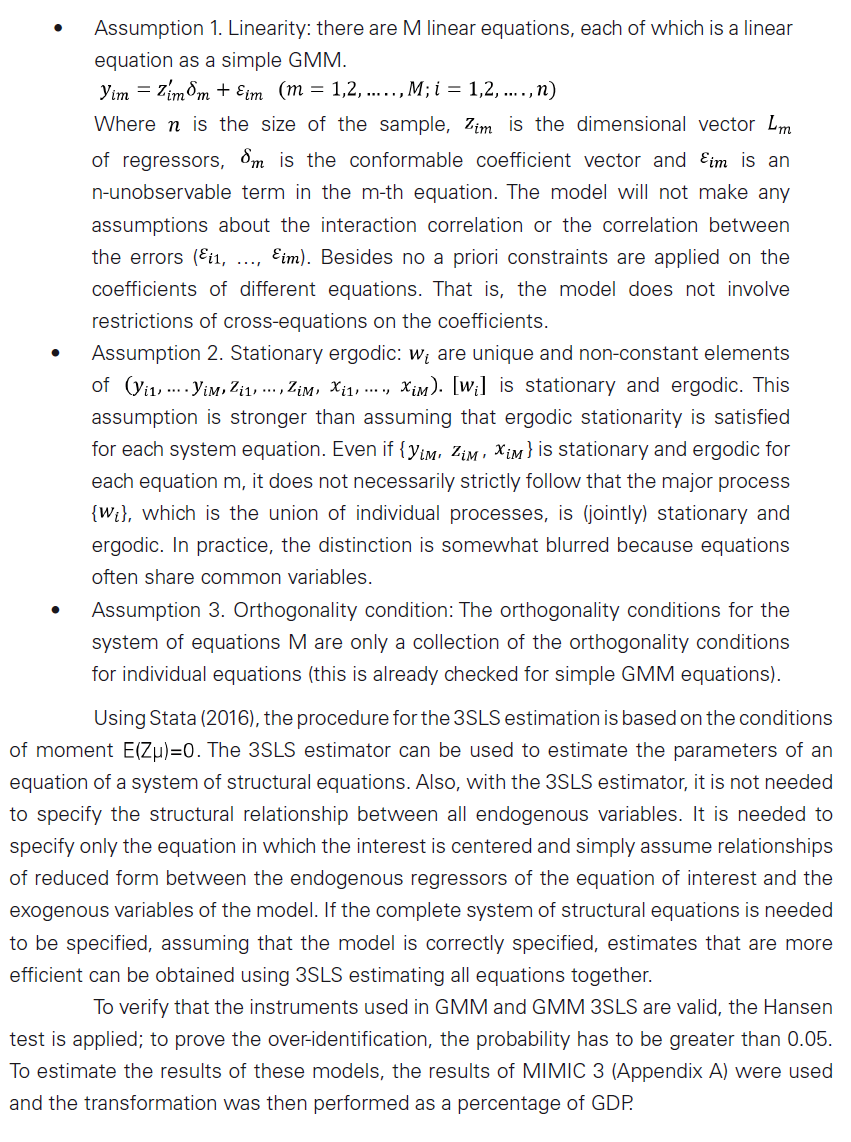
9. Results, conclusions and recommendations
The final model to estimate the dimension for informal economy was the MIMIC 3 showed
in Appendix A, and the results are found in Appendix B and Appendix C. The same analysis
was performed by Adame and Tuesta (2017) to study the impact of informal economy on
both institutional variables (corruption control, government efficiency, tax collection and
state effectiveness) and macroeconomic variables (self-employment, GINI, unemployment
rate and GDP growth). More results are shown in Appendix D.
According to the present research, the estimated average size of informal
economy as a percentage of the GDP for Latin America is 34% while, in the case of the
OCDE countries, it is 19.83%, a little bit less than a half of the Latin American average.
The difference between those groups of countries is due to institutional efficiencies and
the economic development of each country. The country with the biggest informality in
America Latina is Peru, with 37.4% of the GDP for 2016; in the case of the OCDE countries,
it is Turkey with 29.75% for the same period time. Moreover, the Latin American country
with less informality is Uruguay with 14.47% while in the OCDE countries is Denmark with
12.84%, both for 2016.
In Hassan and Schneider’s results for 2013, the dimension of the informal economy
for Peru (60.9%) is approximately less than twice the estimated in the present research.
The 17.3% estimation made by the INEI (2016) shows a figure which is approximately onethird
of the number gotten by Schneider. Finally, this research shows proportion which
is a bit less than the double of the INEI’s estimation, although the trend is the same in
both cases (INEI and the present research). The countries with larger informal economy
according to Hassan and Schneider (2016) are Bolivia (66.04%) and Honduras (72.41%)
followed by Mexico (31.19%) and Greece (39.39%). A possible explanation for the big
number in Hassan and Schneider’s results is the fact that they included in their model the
demand of money as an indicator with the premise that an excess of demand over supply
is due to informality, but it may be also explained by the existence of illicit activities that
demand cash.
The results indicate that for Peru, Latin America and OECD countries, the tax
collection has been negatively affected due to the dimension of the informal economy. In
the case of Latin America, the policies applied to reduce the informal sector have resulted
in an average reduction from 34% to 31.4% between 1995 and 2016. In contrast, for OECD
countries, it remained at 20% throughout the years of study. In both cases, it can be
inferred that policies to reduce informal economy such as reducing taxes and eliminating
economic barriers to become formal have not been successful. These results opened new
lines of research to find out the motivations to stay in the informal economy and to question
the insertion into formality.
For Latin America, De Soto (1980) statements on the informality as a source of
entrepreneurship are confirmed since the GMM 3SLS estimation shows a positive impact
of the informal economy on the economic growth. The opposite happens in the case of
OCED countries, where a negative effect could be found. For both Latin America and OCED
countries, the informal economy harms the amount of collected taxes.
Although the informal economy is present in all countries, it is greater in the
developing ones and the fixed effect in each country is persistent. Thus, solutions must
not be the same for all countries and must consider the differences in cultures and
idiosyncrasy. Policies such as barriers reductions for formalization or tax reductions are not
solutions by themselves in isolation. The institutional framework (including the government)
is an important factor to increase or decrease the informal economy. If institutions are not
interested in being more efficient, transparent and committed to people’s welfare, it is
less probable that the informal economy could be reduced. The institutional issue must be
addressed definitively considering the elimination of corruption at all levels of the economy.
In the same line, Laws and regulations must not only be clear to prevent unequal application
but also must be fulfilled regardless of who the subject is. Moreover, the self-employment
and unemployment are directly related to informal employment, which absorbs what formal
employment could not recruit. The Gini coefficient is an important indicator because a
country with higher inequality would probably have a bigger informal economy.
The controversy about MIMIC models is well-known. Although to better improve
the goodness of fit, after getting the slope of the informal economy using the MIMIC,
the adjustment procedure could be calibrated considering the INEI’s first study about the
informal economy in Peru. Another criticism of the MIMIC model is the fact that illicit
activities cannot be completely separated from informal activities because the former
groups hide their income. Finally, the model requires a great amount of data and, therefore,
it is not possible to analyze only one country.
Some conclusions can be obtained after all the research review. First of all, the
need to reinforce theoretical framework in order to understand the informal economy as
agents’ behavior. Secondly, a unique solution (a recipe) is not feasible: we need to adapt the
possible solutions to the specific causes of informal economy in each country. Thirdly, all
agents (government and institutions, formal sector, informal sector and individual agents)
must be considered because each particular behavior exerts an effect on the dimension of
the informal economy. Fourthly, facts such as confidence in the government and politicians,
transparency and efficiency in the government’s expenditures, elimination of corruption,
increasing the perceived social welfare and education are probably more important and
effective variables to take into account to reduce informality than tax reduction programs. A
complete set of formalization policies must be considered besides creating and maintaining
economic growth. Lastly, it should be understood that the final result will be seen in the
long run.
From the point of view of public management, trying to solve the problem does
not only mean taking the perspective of the rational economic actor but combining it with
that of the social actor: whether an agent’s participation in the informal sector is due to
a low moral tax measured or by what is called the civil morality (Williams, Horodnic, &
Burkinshaw, 2016). In this context, the way to solve the informality problem would be to
incentivize the tax morality, independently of the other policy measures that the state can
adopt. But for this to happen, governments must increase, promote and communicate
(not only with rules but with their actions) the «state morality» as an institution (Williams,
Horodnic, & Burkinshaw, 2016, p. 368). This state morality has to do with the moral
responsibilities of the state. For the application of this idea, the thought of Williams (1923)
must be followed while defining a conception of the state:
A community of people socially united; secondly, a piece of political machinery
termed a government, and administered by a corps of officials termed a magistracy;
and thirdly, a body of rules or maxims, written or unwritten, determining the scope
of this public authority and the manner of its exercise. (p. 22).
And one way to increase both the civic morality (which includes tax morality) and
the state morality is through education.
It is also necessary to understand that informal agents are not criminals and that
informality should be analyzed considering two basic things that sometimes go unnoticed:
on the one hand, informality in Peru has a lot to do with social and economic inequalities;
and on the other hand, it is a mechanism of capitalist development of an enterprise that, if
well managed, could positively stimulate economic growth. From this standpoint of view,
government’s policies must-see at informals as entrepreneurs who requiered in most cases
education, social protection, financing, technology and improvement of skills to develop
their enterprises (Lupi, 2018). And that's the place where management science could help
the informal entities to successfully achieve their potential.
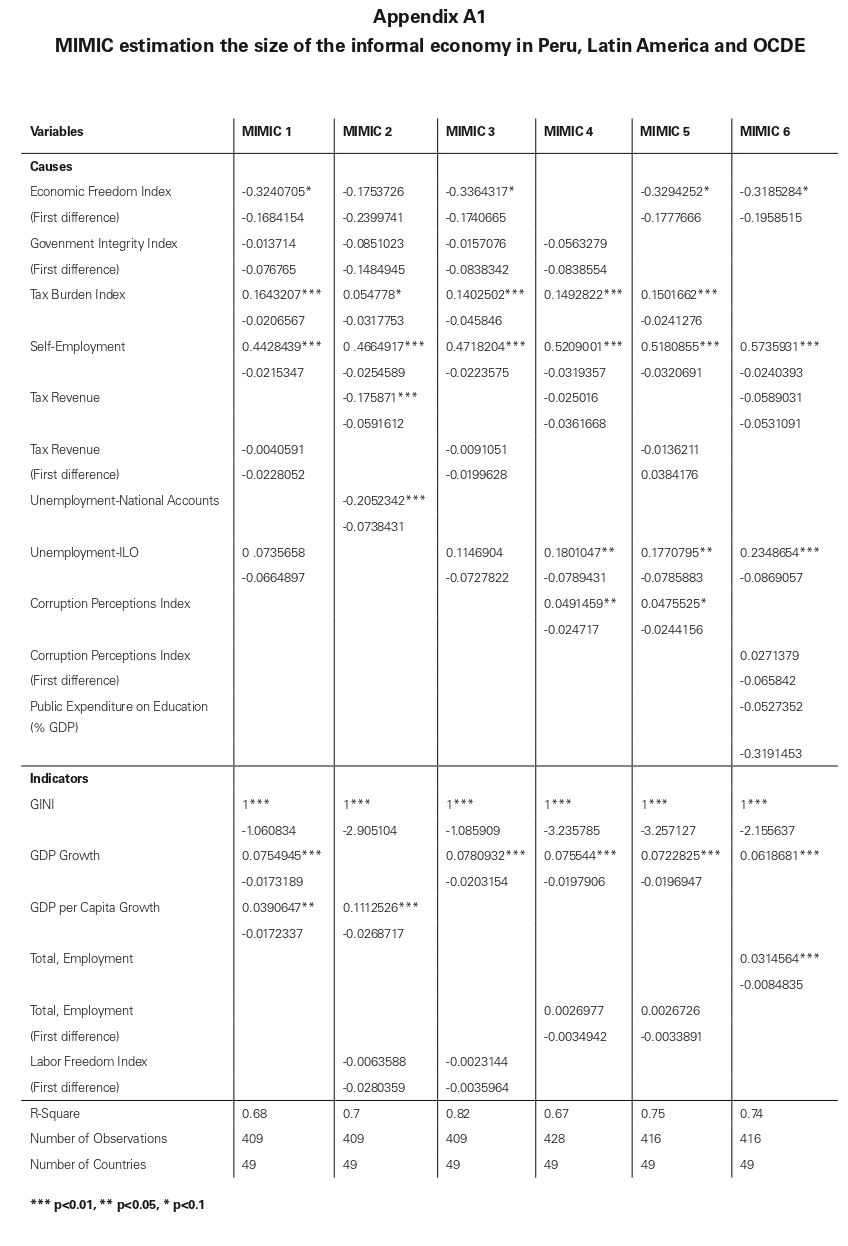
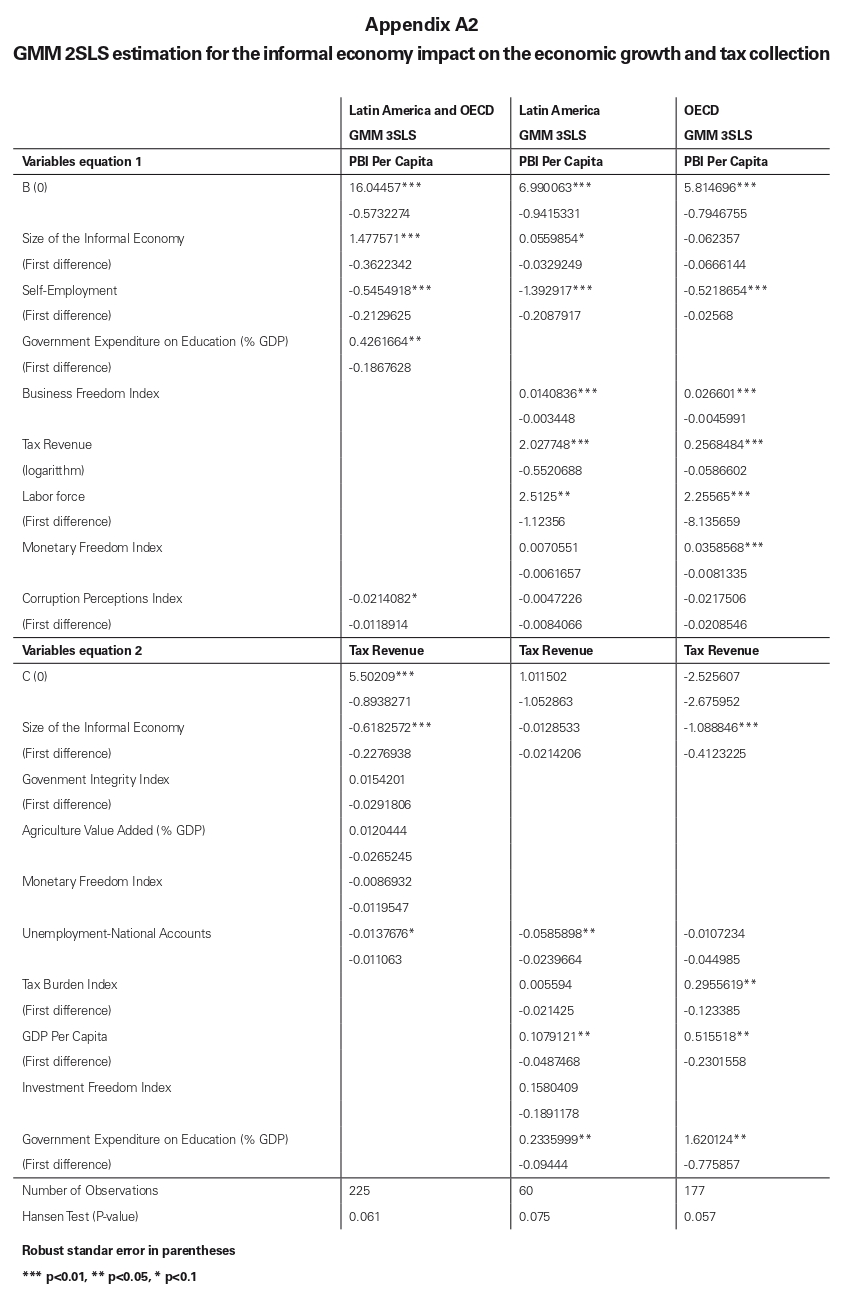
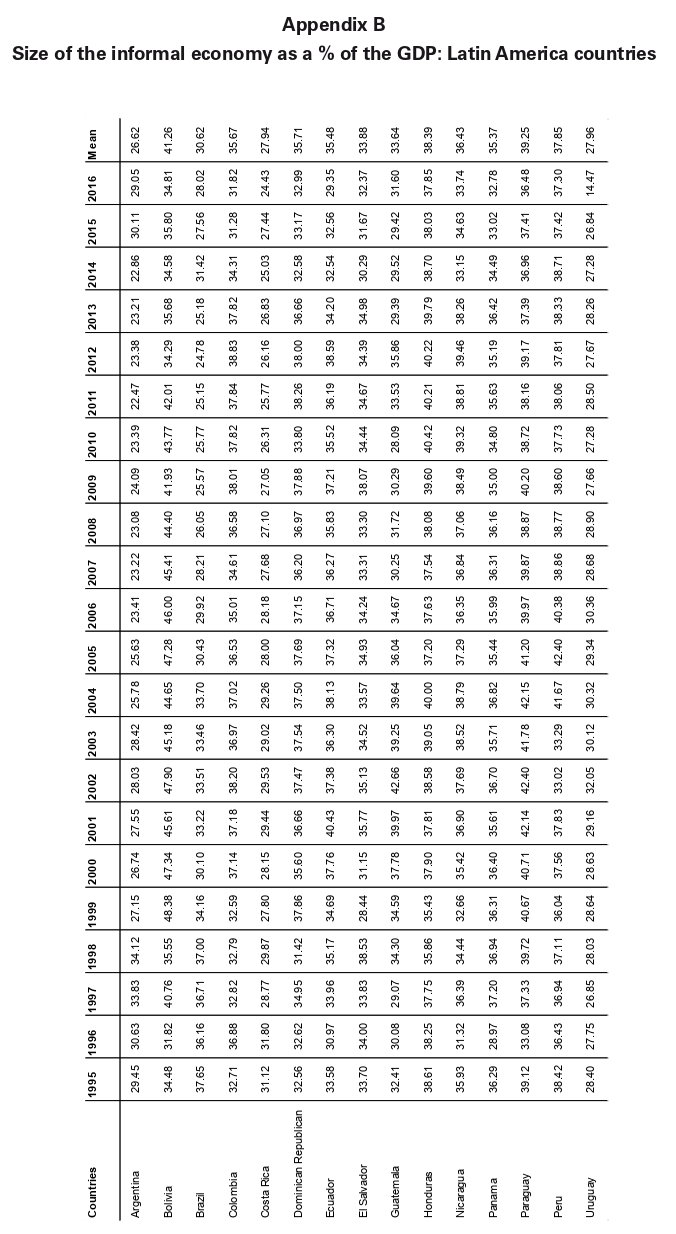
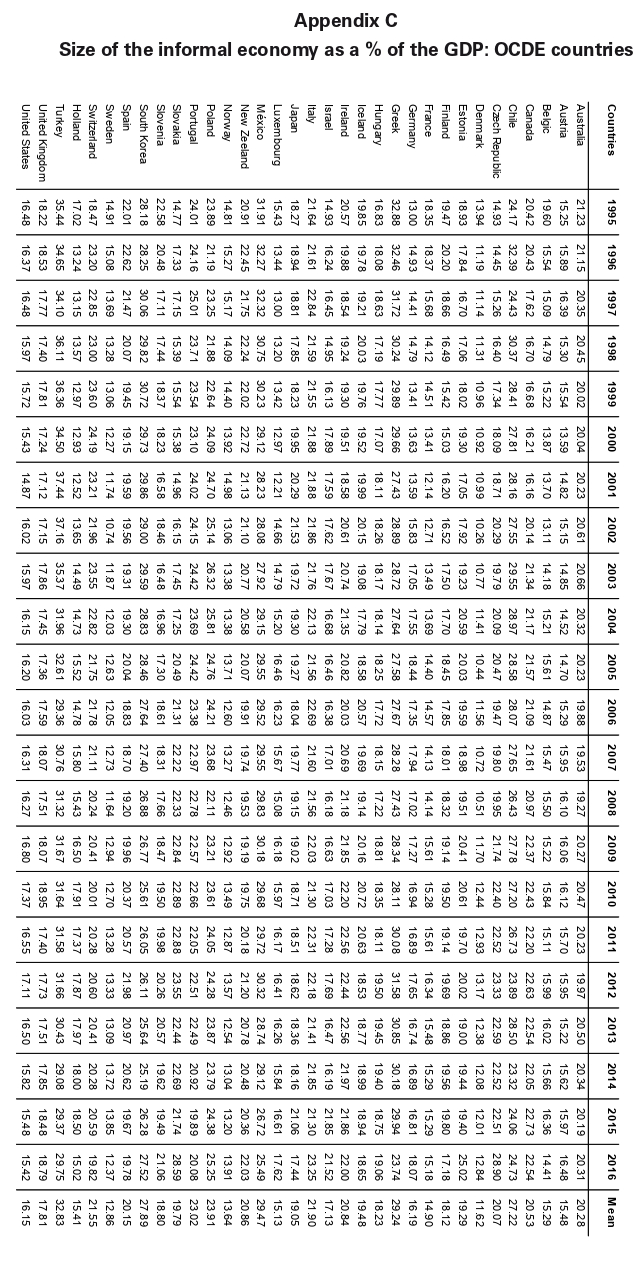
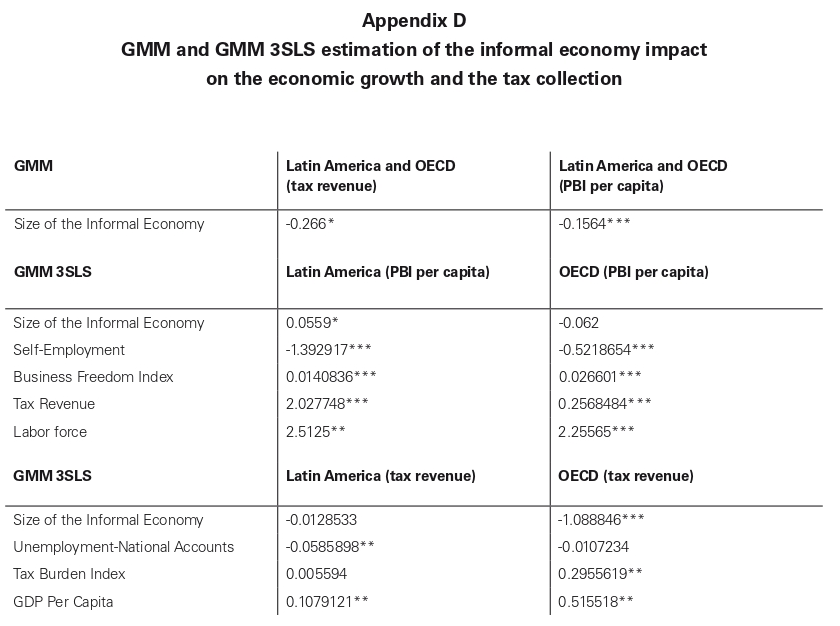
|
| |
| |
| |
| |
| |
|
Bibliografía
Abid, M.
(2016)-Size and implication of the informal
economy in African countries: Evidence
from a structural model. International
Economic Journal, 30(4), 571-598. DOI:
10.1080/10168737.2016.1204342
Achua, C., & Lussier, R.
(2014)-Entrepreneurial drive and the informal
economy in Cameroon. Journal of
Developmental Entrepreneurship, 19(4).
Retrieved from: https://doi.org/10.1142/
S1084946714500241
Acock, A.
Structural equation modeling. Discovering
structural equation Modeling Using Stata,
115-152. Washington: STATA Press.
Adame, V., & Tuesta, D.
(2007)-El laberinto de la economía informal:
estrategias de medición e impactos. BBVA
Research Working Paper 17/17.
Allingham, M., & Sandmo, A.
(1972)-Income tax evasions: A theoretical
analysis. Journal of Public Economics, 1(3),
323-338.
Andrei, Tudorel, Stefanescu, Daniela & Oancea, Bogdan
(2010)-Quantitative methods for evaluating the
informal economy. Theoretical and Applied
Economics, 17(7), 15-24.
Aruoba, S.B.
(2010)-The Informal sector, government policy
and institutions. Society for Economic
Dynamics.
BID.
(2010)-La era de la productividad. Cómo
transformar las economías desde sus
cimientos, 1-29. Washington: Fondo de
Cultura Económica.
BID.
(2012)-Recaudar no basta: Los impuestos como
instrumento de desarrollo. Washington:
Fondo de Cultura Económica.
Bird, R., Martinez-Vasquez, J. & Torgler, B.
(2008)-Tax effort in developing countries and
high income countries: The impact of
corruption, Voice Accountability. Economic
Analysis and Policy, 38(1), 55-71.
Bird, R., Martinez-Vasquez, J. & Torgler, B.
(2014)-Societal institutions and tax effort. Annals
of Economics and Finance, 15(1), 301-351.
Bologna, J.
(2015)-The effect of informal employment and
corruption on income levels in Brazil.
Journal of Comparative Economics, 44(3),
657-695.
Bovi, M., & Dell’Anno, R.
(2009)-The changing nature of the OECD
shadow economy. Journal of Evolutionary
Economics. Springer 2019.
Brambila, M.J, & Cazzavillan, G.
(2010)-Modeling the informal economy in Mexico.
A structural equation approach. The Journal
of Developing Areas, 44(1), 345-365.
Breusch, T.
(2005)-The Canadian underground economy: An
examination of Giles and Tedds. Canadian
Tax Journal. 53(2), 367-391.
Breusch, T.
Estimating the underground economy
using MIMIC models. EconWPA, 1-35.
Bruton, G.D., Ireland, R.D. &
Ketchen Jr., D.J.
(2005)-Toward a research agenda on the informal
economy. Academy of Management
Perspectives, 26(3), 1-11. DOI: 10.5465/
amp.2012.0079
Buehn, A., Dell’Anno, R. & Schneider, F.
(2012)-Fiscal illusion and the shadow economy:
Two sides of the same coin?. Munich
Personal RePEc Archive.
CEPLAN
(2016)-Economía informal en Perú: Situación
actual y perspectivas. Lima.
Céspedes, R. N.
(2015a)-Crecer no es Suficiente para Reducir la
Informalidad. Lima: BCRP.
Chattopadhyay, S., & Mondal,R.
(2016)-Investment and growth in a developing
economy with vast informal sector. The
Journal of Developing Areas, 50(4), 113-
132.
Chen, A.M.
(2012)-La economía informal: definiciones, teorías y políticas. WIEGO.
Choy, J.P., & Thum, M.
(2003)-Corruption and the shadow economy. Dresden discussion paper in economics.
Colin, C.W.
(2006)-Explaining the hidden enterprise
culture. The hidden enterprise culture:
Entrepreneurship in the underground
economy, 92-97. Massachusetts: Edward
Elgar Pub.
Colin, W.C., & Nadin, S.
(2011)-Theorizing the hidden enterprise
culture: the nature of entrepreneurship
in the shadow economy. Journal
Entrepreneurship and Small Business,
14(3), 334-348.
Darbi, W., & Knott, P.
(2016)-Strategizing practices in an informal
economy setting: A case of strategic
networking. European Management
Journal, 34(1), 400-413.
Davoodi, H., & Grigorian, D.
(2007)-Tax potencial vs. tax effort: A cross-country
analysis of Armenia Stubbornly Low Tax
collection. IMF Working Paper.
De Soto, H.
(1986)-El otro sendero. Lima: Instituto Libertad y Democracia.
Dell'Anno, R., & Schneider, F.
(2009)-A complex approach to estimate the
shadow economy: The structural equation
modeling. In M. Faggini and T. Lux (Eds).
Coping with the complexity of economics,
111-130. Verlag, Italy: Springer.
Eilat, Y., & Zinnes, C.
(2000)-The evolution of the shadow economy in
transitions countries: Consequences for
economic growth and donor assistance.
Harvard Institute for International
Development. CAER II Discussion Paper
83, 11-69. Retrieved from: http://citeseerx.
ist.psu.edu/viewdoc/download;jsessionid
=57CDE74EDE5653D9626C731EA5FEA
0C4?doi=10.1.1.470.2018&rep=rep1&ty
pe=pdf
Elgin, C.
(2010)-Political turnover, taxes and the shadow
economy. Department of Economics at
Bogazici University, 1-51. Retrieved from:
http://www.econ.boun.edu.tr/public_html/
RePEc/pdf/201008.pdf
Elgin, C., & Garcia, M.
(2011)-Public trust, taxes and the informal sector.
Journal Review of Social, Economic and
Administrative Studies, 26(1), 27-44.
Retrieved from: http://www.acarindex.com/
dosyalar/makale/acarindex-1423873575.pdf
Elgin, C., & Oztunali, O.
(2012)-Shadow economies around the World:
Model based estimates. Department of
Economics at Bogazici University Working
Papers 2012/05, 1-48. Retrieved from:
http://www.econ.boun.edu.tr/public_html/
RePEc/pdf/201205.pdf
Elgin, C., & Oztunali, O.
(2014)-Institutions, informal economy, and
economic development. Emerging Markets
Finance & Trade, 50(4), 145-162.
Elgin, C., & Schneider, F.
(2016)-Shadow economies in OECD countries:
DGE vs. MIMIC approaches. Journal
Review of Social, Economic and
Administrative Studies, 30(1), 51-75.
Enste, D., & Schneider, F.
(1998)-Increasing shadow economies all over the
World - Fiction or reality? Institute for the
Study of Labor Discusion Paper 26, 1-65.
Retrieved from: http://ftp.iza.org/dp26.pdf
Enste, D.
(2015)-The shadow economy in industrial
countries. Institute for the Study of Labor
Discusion Paper 2(127), 1-11. Retrieved
from: https://wol.iza.org/uploads/
articles/457/pdfs/shadow-economy-inindustrial-
countries.pdf?v=1
Farrell, D.
(2004)-The Hidden dangers of the informal
economy. McKinsey Quarterly. Retrieved
from: https://www.mckinsey.com/featuredinsights/
employment-and-growth/thehidden-
dangers-of-the-informal-economy
Feige, E. L.
(1997)-Underground activity and institutional
change: productive, protective and
predatory behavior in transition economies.
In J.M. Nelson, C. Tilly, and L. Walker
(Eds.). Transforming post-comunist political
economies, 21-34. Washington, DC:
National Academy Press.
Feld, L. P., & Schneider, F.
(2010)-Survey on the shadow economy and
undeclared earnings in OECD countries.
German Economic Review, 11(2), 109-149.
Filippin, A., Fiorio, C., & Viviano, E.
(2013)-The effect of tax enforcement on tax
moral. Bank of Italy, Economic Research
and International Relations Area Economic
Working Paper 937, 1-29.
Frey, B., & Schneider F.
(2001)-Informal and underground economics.
In N.J. Semelser and P.B. Baltes (Eds.).
International Encyclopedia of the Social
and Behavioral Sciences (1st ed.), 7441-
7446.
Frey, B., & Weck, H.
(1983)-Estimating the Shadow Economy: A naive
Approach. Oxford Economic Papers, 35(1),
23-44.
Friedman, E., Johnson, E.,
Kaufmann, D., &
Zoido-Lobaton, P.
(2000)-Dodging the Grabbing Hand: The
Determinants of Unofficial Activities in 69
Countries. Journal of Public Economics,
76(3), 459-493.
Galiani, S., & Weinschelbaum,F.
(2011)-Modeling Informality Formally: Households
and Firms. Economic Inquiry, 50(3), 821-
838.
Gibbs, S.R., Mahone Jr., C.E., & Crump, M.E.S.
(2014)-A Framework for informal economy entry:
Socio-spatial, necessity-opportunity, and
structural-based factors. In M. Bressler
(ed.). Academy of Entrepreneurship
Journal 20(2), 33-58. Weavervile, USA:
Jordan Whitney Enterprises Inc.
Goel, R.K., & Nelson, M.A.
(2016)-Shining a light on the shadows: Identifying
robust determinants of the Shadow
Economy. Economic Modelling, 58(1),
351-364.
Gokalp, O., & Lee, S.H.P.
(2016)-Competition and corporate tax evasion:
An institution-based view. Journal of World
Business, 52(2), 258-269.
Goldberger, A.S.
(1972)-Structural equation methods in the social
sciences. Econometrica, 40(6), 979-1001.
Gómez, S.J., & Moran, D.
(2012)-Informalidad y tributación en América
Latina: Explorando los nexps para mejorar
la equidad. Serie Macroeconomia el
Desarrollo 124. Santiago: CEPAL.
Gylys, P.
(2005)-Economy, anti-economy, underground
economy: Conceptual and terminological
problems. Ekonomika, 72. Vilnius University
Publishing House.
Hart, K.
(1973)-Informal income opportunities and urban
employment in Ghana. Journal of Modern
African Studies, 11(1).
Haslinger, F.
(1985)-Reciprocity, loyalty, and the growth of the
underground-economy: A theoretical note.
European Journal of Political Economy,
1(3), 309-323.
Hassan, M., & Schneider, F.
(2016)-Size and development of the shadow
economies of 157 countries Worldwide:
Updated and new measures from 1999 to
2013. Journal of Global Economics, 4(3),
1-14.
Hayashi, F.
(2000)-Multiple-equation GMM. En F. Hayashi (Ed.). Econometrics, 258-320.
Hayashi, F.
(2000)-Single-equation GMM. En F. Hayashi (Ed.). Econometrics, 198-202.
Hernandez A.M.
(2009)-Estimating the size of the informal
economy in Peru: A currency demand
approach. Revista de Ciencias
Empresariales y Económicas.
INEI
(2014)-Produción y empleo informal en el Perú:
cuenta satélite de la economía informal
2007-2012. Lima: INEI.
INEI
(2016)-Evolución de la pobreza monetaria 2009- 2015. Lima: INEI.
INEI
(2016)-Producción y empleo informal en el Perú:
cuenta satélite de la economía informal
2007-2015. Lima: INEI.
INEI
(2017)-http://www.inei.gob.pe/. Retrieved from:
https://www.inei.gob.pe/estadisticas/
indice-tematico/education/
Joshi, Anuradha; Prichard, Wilson & Heady, Christopher
(2014)-Taxing the informal economy: The current
state of knowledge and agendas for future
research. The Journal of Development
Studies, 50(10), 1325-1347.
Kaufmann, D., Kraay, A. & Mastruzzi, M.
(2014)-Governance matters III: Governance
indicators for 1996-2014. World Bank.
La Porta, R., & Shleifer. A.
(2008)-The economic consequences of legal
origins. Journal of Economic Literature,
46(2), 285-332.
Loayza, N.
(1997)-The economics of the informal sector: A
simple model and some empirical evidence
from Latin America. Lima: The World Bank.
Loayza, N.
(2007)-The causes and consequences of informality in Peru. BCRP.
Loayza, N.
(2016)-Informality in the process of development
and growth. World Bank Group.
Loayza, N. V., Serven, L., & Sugawara, N.
(2009)-Informality in Latin America and the Caribbean. The World Bank.
Lupi, A.
(2018)-Main sectoral approaches of policies
designed to tackle the informal economy.
Retrieved from: https://europa.eu/
capacity4dev/rnsf-mit/wiki/43-mainsectoral-
approaches-policies-designedtackle-
informal-economy
Machado, R.
(2014)-La economía informal en el Perú: magnitud
y determinantes (1980-2011). Apuntes,
41(74), 197-233. Lima: Fondo Editorial de la
Universidad del Pacífico.
Mathias, B., Lux, S., Crook, R.,
Autry, C., & Zaretzki, R.
(2015)-Competing against the unknown: The
impact of enabling and constraining
institutions on the informal economy.
Journal of Business Ethics, 127(2), 241-
264.
McGahan, A.
(2012)-Challenges of the informal economy for
the field of management. Academy of
Management Perspectives, 26(3), 12-21.
MEF.
(2016)-Marco macroeconomico multianual 2017-
2019 Revisado. LIMA: MEF.
Milner, H., & Rudra, N.
(2015)-Globalization and the political benefits
of the informal economy. International
Studies Review, 17(4), 664-669.
Mukherjee, D.
(2016)-Informal economy in emerging economies:
not a substitute but a complement!
International Journal of Business and
Economic Development, 4(3).
Nagac, K.
(2015)-Tax system and informal economy: a
cross-country analysis. Applied Economics,
47(17), 1775-1787.
North, D. C.
(1990)-Institutions, institutional change and
economic performance. Cambridge:
Cambridge University Press.
OCDE
(2002)-Measuring the non-observed economy: A
handbook. OCDE. Paris: OECD Publishing.
OCDE, CEPAL, CIAT, & BID
(2016)-Estadisticas tributarias en América Latina y
el Caribe 2016. Paris: OECD Publishing.
OCDE, ECLAC, CIAT, & IDB
(2016)-Revenue statistics in Latin America
and the Caribbean 2016. Paris : OECD.
Retrieved from: http://www.cepal.org/
es/comunicados/america-latina-caribeingresos-
tributarios-aumentan-ligeramentepero-
aun-se-mantienen
Ogunc, Fethi, Yilmaz & Gokhan
(2000)Estimating the underground economy in
Turkey. The Central Bank of the Republic of
Turkey Research Department.
OIT
(1972)-Employment, incomes and equality:
A strategy for increasing productive
employment in Kenya. Ginebra: OIT.
Pathak, S., & Xavier-Oliveira, E.
(2015)-Technology use and availability in
entrepreneurship: informal economy as
moderator of institutions in emerging
economies. The Journal of Technology
Transfer, 41(3), 506-529.
Petrescu, I.
(2016)-The Effects of economic sanctions on the
informal economy. Management Dynamics
in the Knowledge Economy, 4(14), 623-
648.
Sassen, S.
(1994)-The Informal economy: Between new
developments and old regulations. The Yale
Law Journal, 103(8), 2289-2304. Retrieved
from: http://www.jstor.org/stable/797048
Satorra, A., & Bentler, P.
(1994)-Corrections to test statistic and standar
errors in covariance structure analysis.
SAGE Publications Inc.
Schneider, F., & Buehn, A.
(2009)-Shadow economies and corruption all
over the World: Revised estimates for
120 Countries. Economics: The Open-
Access, 2(1), 1-53. Retrieved from: http://
www.economics-ejournal.org/economics/
journalarticles/2007-9
Schneider, F., & Colin, W.
(2013)-The shadow economy. London: The
Institute of Economic Affairs.
Semboja, J.
(2001)-Why people pay taxes: The case of the
development levy in Tanzania. Tanzania.
World Development, 29(12), 2059-2074.
Smith, D. J.
(1987)-Measuring the informal economy.
The Annals of the American Academy
of Political and Social Science,
493(1), 83-99. DOI: https://doi.
org/10.1177/0002716287493001007
Stata
(2016)-http://www.stata.com/. Retrieved from:
http://www.stata.com/: http://www.stata.
com/manuals13/rgmm.pdf
Tanzi, V.
(1982)-Fiscal disequilibrium in developing
countries. World Development, Vol. 10, No.
12, 1069-1082. Retrieved from: https://doi.
org/10.1016/0305-750X(82)90019-5
Tokman, V.
(1984)-Wages and employment in international
recessions: Recent Latin American
experience. The Helen Kellogg Institute
for International Studies. Working Paper
11. Retrieved from: https://kellogg.
nd.edu/sites/default/files/old_files/
documents/011_0.pdf
Tokman, V.
(1992)-Beyond regulation: The informal economy
in Latin America (1st ed.). Boulder, CO:
Lynne Rienner Publishers.
Torgler, B., & Schneider, F.
(2007)-The impact of tax morale and institutional
quality on the shadow economy. The
Institute for the Study of Labor Discussion
Paper 254, 1-46.
Voicu, Cristina
(2012)-Economics and «underground» economy
theory. Theoretical and Applied Economics,
Vol. XIX(7), 71-84
Wan Jie, S., Huam, T., Rasli, A.,
& Thean Chye, L.
(2011)-Underground economy: Definitions and
causes. Business and Management
Review, 1(2), 14-24.
Webb, J.W., Bruton, G.D., Tihanyi, L., & Ireland, R.D.
(2013)-Research on entrepreneurship in the
informal economy: Framing a research
agenda. Journal of Business Venturing,
1(17). DOI: 10.1016/j.jbusvent.2012.05.003
Webb, J.; Ireland, D. & Ketchen, D.
(2014)-Toward a greater understanding of
entrepreneurship and strategy in
the informal economy. Strategic
Entrepreneurship Journal, 8(1), 1-15.
Wei, S.
(1997)-Why is corruption so much more taxing
than tax? Arbitrariness kills. The National
Bureau of Economic Research. WP 6255,
1-25. Retrieved from: https://www.nber.
org/papers/w6255
Welter, F., Smallbone, D., & Pobol, A.
(2015)-Entrepreneurial activity in the
informal economy: a missing piece
of the entrepreneurship jigsaw
puzzle. Entrepreneurship & Regional
Development, 27(1), 292-306.
Williams, B.
(1923)-State morality in international relations.
The American Political Science Review,
17(1), 17-33. Retrieved from: https://www.
jstor.org/stable/pdf/1943790.pdf
Williams, C.
(2015)-Explaining the informal economy: An
exploratory evaluation of competing
perspectives. Industrial Relations, 70(4),
741-765.
Williams, C.
(2015)-Tackling entrepreneurship in the informal
sector: an overview of the policy
options. Journal of Developmental
Entrepreneurship, 20(1).
Williams, C., Horodnic, I., &
Burkinshaw, L.
(2016)-Evaluating competing public policy
approaches towards the informal economy.
International Journal of Public, 29(4).
Wilson, D. Tamar
(2011)-economy. Urban Anthropology and Studies
of Cultural Systems and World Economic,
40(3/4), 205-221.
Fecha de recepción: 03 de octubre de 2018
Fecha de aceptación: 15 de noviembre de 2018
|
|

|
|